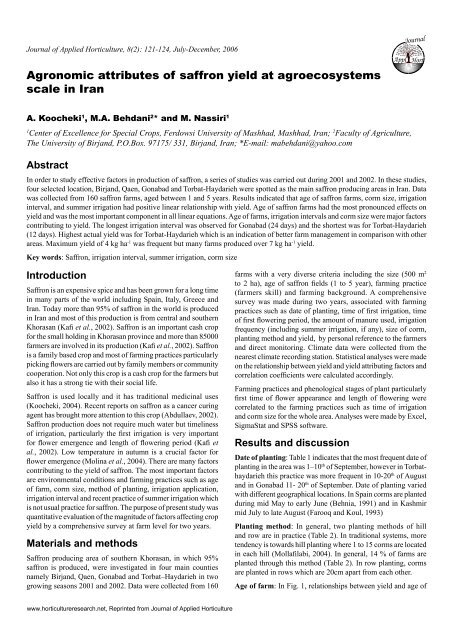Journal of Applied Horticulture, Vol 8(2)
Journal of Applied Horticulture, Vol 8(2)
Journal of Applied Horticulture, Vol 8(2)
Create successful ePaper yourself
Turn your PDF publications into a flip-book with our unique Google optimized e-Paper software.
<strong>Journal</strong> <strong>of</strong> <strong>Applied</strong> <strong>Horticulture</strong>, 8(2): 121-124, July-December, 2006Agronomic attributes <strong>of</strong> saffron yield at agroecosystemsscale in IranAppl<strong>Journal</strong>A. Koocheki 1 , M.A. Behdani 2 * and M. Nassiri 11Center <strong>of</strong> Excellence for Special Crops, Ferdowsi University <strong>of</strong> Mashhad, Mashhad, Iran; 2 Faculty <strong>of</strong> Agriculture,The University <strong>of</strong> Birjand, P.O.Box. 97175/ 331, Birjand, Iran; *E-mail: mabehdani@yahoo.comAbstractIn order to study effective factors in production <strong>of</strong> saffron, a series <strong>of</strong> studies was carried out during 2001 and 2002. In these studies,four selected location, Birjand, Qaen, Gonabad and Torbat-Haydarieh were spotted as the main saffron producing areas in Iran. Datawas collected from 160 saffron farms, aged between 1 and 5 years. Results indicated that age <strong>of</strong> saffron farms, corm size, irrigationinterval, and summer irrigation had positive linear relationship with yield. Age <strong>of</strong> saffron farms had the most pronounced effects onyield and was the most important component in all linear equations. Age <strong>of</strong> farms, irrigation intervals and corm size were major factorscontributing to yield. The longest irrigation interval was observed for Gonabad (24 days) and the shortest was for Torbat-Haydarieh(12 days). Highest actual yield was for Torbat-Haydarieh which is an indication <strong>of</strong> better farm management in comparison with otherareas. Maximum yield <strong>of</strong> 4 kg ha -1 was frequent but many farms produced over 7 kg ha -1 yield.Key words: Saffron, irrigation interval, summer irrigation, corm sizeIntroductionSaffron is an expensive spice and has been grown for a long timein many parts <strong>of</strong> the world including Spain, Italy, Greece andIran. Today more than 95% <strong>of</strong> saffron in the world is producedin Iran and most <strong>of</strong> this production is from central and southernKhorasan (Kafi et al., 2002). Saffron is an important cash cropfor the small holding in Khorasan province and more than 85000farmers are involved in its production (Kafi et al., 2002). Saffronis a family based crop and most <strong>of</strong> farming practices particularlypicking flowers are carried out by family members or communitycooperation. Not only this crop is a cash crop for the farmers butalso it has a strong tie with their social life.Saffron is used locally and it has traditional medicinal uses(Koocheki, 2004). Recent reports on saffron as a cancer curingagent has brought more attention to this crop (Abdullaev, 2002).Saffron production does not require much water but timeliness<strong>of</strong> irrigation, particularly the first irrigation is very importantfor flower emergence and length <strong>of</strong> flowering period (Kafi etal., 2002). Low temperature in autumn is a crucial factor forflower emergence (Molina et al., 2004). There are many factorscontributing to the yield <strong>of</strong> saffron. The most important factorsare environmental conditions and farming practices such as age<strong>of</strong> farm, corm size, method <strong>of</strong> planting, irrigation application,irrigation interval and recent practice <strong>of</strong> summer irrigation whichis not usual practice for saffron. The purpose <strong>of</strong> present study wasquantitative evaluation <strong>of</strong> the magnitude <strong>of</strong> factors affecting cropyield by a comprehensive survey at farm level for two years.Materials and methodsSaffron producing area <strong>of</strong> southern Khorasan, in which 95%saffron is produced, were investigated in four main countiesnamely Birjand, Qaen, Gonabad and Torbat–Haydarieh in twogrowing seasons 2001 and 2002. Data were collected from 160farms with a very diverse criteria including the size (500 m 2to 2 ha), age <strong>of</strong> saffron fields (1 to 5 year), farming practice(farmers skill) and farming background. A comprehensivesurvey was made during two years, associated with farmingpractices such as date <strong>of</strong> planting, time <strong>of</strong> first irrigation, time<strong>of</strong> first flowering period, the amount <strong>of</strong> manure used, irrigationfrequency (including summer irrigation, if any), size <strong>of</strong> corm,planting method and yield, by personal reference to the farmersand direct monitoring. Climate data were collected from thenearest climate recording station. Statistical analyses were madeon the relationship between yield and yield attributing factors andcorrelation coefficients were calculated accordingly.Farming practices and phenological stages <strong>of</strong> plant particularlyfirst time <strong>of</strong> flower appearance and length <strong>of</strong> flowering werecorrelated to the farming practices such as time <strong>of</strong> irrigationand corm size for the whole area. Analyses were made by Excel,SigmaStat and SPSS s<strong>of</strong>tware.Results and discussionDate <strong>of</strong> planting: Table 1 indicates that the most frequent date <strong>of</strong>planting in the area was 1–10 th <strong>of</strong> September, however in Torbathaydariehthis practice was more frequent in 10-20 th <strong>of</strong> Augustand in Gonabad 11- 20 th <strong>of</strong> September. Date <strong>of</strong> planting variedwith different geographical locations. In Spain corms are plantedduring mid May to early June (Behnia, 1991) and in Kashmirmid July to late August (Farooq and Koul, 1993)Planting method: In general, two planting methods <strong>of</strong> hilland row are in practice (Table 2). In traditional systems, moretendency is towards hill planting where 1 to 15 corms are locatedin each hill (Mollafilabi, 2004). In general, 14 % <strong>of</strong> farms areplanted through this method (Table 2). In row planting, cormsare planted in rows which are 20cm apart from each other.Age <strong>of</strong> farm: In Fig. 1, relationships between yield and age <strong>of</strong>www.horticultureresearch.net, Reprinted from <strong>Journal</strong> <strong>of</strong> <strong>Applied</strong> <strong>Horticulture</strong>


